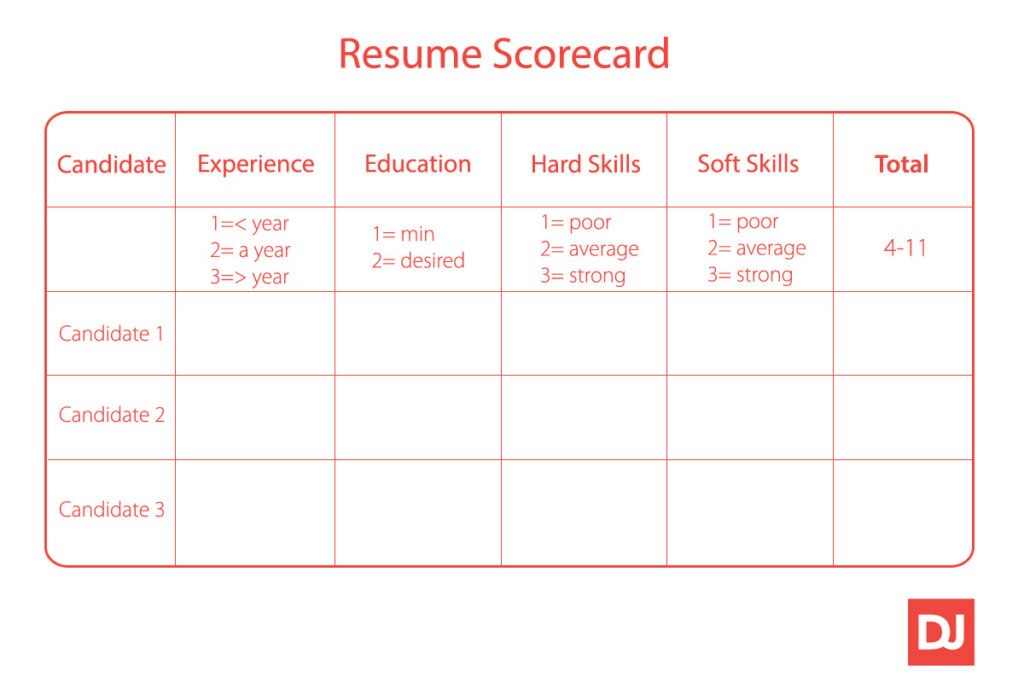The right recruits are essential for the growth and prosperity of any company but sifting through endless piles of resumes is a hefty challenge that requires experience, know-how, and… luck.
As fate would have it, there are plenty of ways one could ease the burden of this task. From a careful selection of what to look for in a resume, to fully automated electronic solutions, let’s explore the paths to the perfect candidates to fill your job order.
Resume Screening: 6 Tips for Reading A CV Like a Pro
At DistantJob, we know that the majority of applicants (up to 80% on average) are likely to be unqualified for the position at hand. It’s vital to learn how to screen resumes and identify suitable candidates to save time and effort.
Set criteria for this purpose, ranging from a person’s professional experience, through their education, to various skills and qualities.
To save yourself the trouble, leave tips and notes such as advice on using an online resume analyzer/checker to grade and correct, so you won’t have to.
A few simple steps can guide you to read resumes and sort them effectively.
1. Qualifications List
As you examine the resumes of successful employees within your company, patterns emerge when comparing traits and expertise. You may observe commonality among education, knowledge, and previous experience.
Talk to employees and their supervisors to identify the list of important qualifications that helped them shine in the field. Pay close attention to soft skills.
2. Minimum and Preferred Qualifications
Next, classify each qualification as either minimum or preferred.
Minimum qualifications are mandatory, as it would be impossible for the candidate to perform the job without these. A web developer, for example, must have superb communication skills and a solid grasp of programming languages.
Preferred qualifications are not vital to the job, but give an edge to potential candidates. Previous experience in similar positions or relevant certifications, for example.
3. Resume Scorecard
Once you know what to look for in a resume, prepare a scorecard to shortlist the strongest candidates.
Split the qualifications into categories like levels of education or amount of previous experience. Dedicate individual columns for the minimum viable skills to ensure the required foundation is always present.
By having a consistent framework, you can quickly sift through resumes, ensuring that you focus on the most important aspects first. This approach minimizes the time spent on each resume while still allowing for a thorough evaluation of the candidate’s qualifications and potential fit for the role.

4. Automation (Optional)
If you have hundreds or even thousands of resumes on the table, it takes a tremendous amount of time and effort to perform the steps above manually. Thanks to the advent of modern technology, there are automated resume screening tools that assist in the recruitment process.
This new category of tools is called AI for recruiting. Such software scans the existing database of employees to identify who is most successful and pulls the required qualifications. It even automates the screening and short-listing of candidates.
When reviewing resumes, there are specific points and precautions to consider.
5. Seek Personalized Content in Applications
A candidate has dedicated effort to understand your organization when their cover letter and resume feature personalized content. Many job seekers distribute identical resumes to various companies or fail to tailor their application documents for a specific position they are genuinely interested in.
When an applicant invests additional time to modify their application to align with your company’s values and needs, it demonstrates their genuine interest and willingness to put in extra effort.
6. Trust Your Instincts, but Be Open-Minded
Sometimes, a resume might not tick all the boxes but still suggests potential. Be open to considering such candidates, especially if they demonstrate transferable skills or unique experiences.
Resume Review Checklist for Recruiters

The ability to effectively evaluate a resume is crucial in identifying the right candidate for any role. With the help of a resume checklist, you can streamline the evaluation process, ensuring a thorough and efficient review. Feel free to save this checklist and use it in your recruitment process.
✅ Assess Against Job Qualifications: Review the open job listing and focus on qualifications relevant for assessing resumes.
✅ Avoid Personal Bias: Disregard the personal information of candidates to prevent subconscious biases.
✅ Focus on Content Over Style: Look beyond stylization and typography. Prioritize the substance of the resume.
✅ Beware of Buzzword Overuse: Be alert to the use of buzzwords that might be used to manipulate recruitment AI.
✅ Examine Professional Experience Details:
- Relevance to the applied position
- Employment duration and reasons for leaving
- Notable awards or recognitions
✅ Note Employment Gaps: Identify significant unemployment periods for discussion in interviews.
✅ Confirm Education Level: Ensure candidates have the required education for the role.
✅ Check Skills and Certifications: Verify relevant skills and professional certifications.
✅ Spelling and Grammar Review: Scrutinize for errors as an indicator of attention to detail and dedication.
✅ Review Online Presence: Examine provided links for social media accounts, portfolios, personal websites, etc.
✅ Verify Consistency of Information: Cross-check resume details with LinkedIn profiles and other sources for discrepancies.
✅ Prepare Interview Questions: Write down questions arising from the resume review, categorizing them for phone screenings and in-person interviews.
✅ Sort Resumes into Categories: – Top applicants for phone screening – Backup list of candidates – Rejected applications
✅ Refine Top Candidates List: If necessary, further narrow down the list of top candidates to a manageable number, ideally around a dozen.
✅ Conduct Phone Screenings: – Provide job details (location, hours, salary, etc.) – Confirm candidate’s continued interest – Ask prepared questions from the review
Red Flags to Watch out in a Resume
In the meticulous process of evaluating resumes, certain red flags can indicate potential concerns about a candidate’s suitability for a position. These include inconsistencies in employment history, such as frequent job changes or unexplained gaps in employment, which may suggest a lack of stability or commitment. Recruiters must be vigilant about these red flags as they can be early indicators of issues that might affect the candidate’s performance or reliability in the role. Here are the common ones:
- Job hopping – Workers who frequently change their occupation may prove to be unreliable;
- Employment gaps;
- Decreasing responsibilities at jobs;
- Short-term employment;
- Essay length paragraphs;
- Lack of information;
- Multiple pages of information;
- First-person narratives;
- Exaggerated titles/jobs/responsibilities;
- Ridiculous email addresses.
Reviewing Resumes – Final Remarks
Resume screening can be a straining experience, but when done meticulously, can help you win invaluable assets for your company. Knowing how to evaluate a resume will reduce the chances of missing out on a strong candidate. The guidelines provided above will increase your screening efficiency, as far as the technical side of things is concerned. When all else fails, sometimes intuition can be the best guide, so don’t be afraid to listen to your gut once in a while.
Once you’re done with the resume screening, it’s time to prepare for the interview with our guide: Tips for a Successful Remote Technical Interview in 2020. And if you need the help of an experienced recruiter, feel free to reach out to us. We’re here to assist you in your hiring process and more. Book a call with us and let’s get to know each other.




